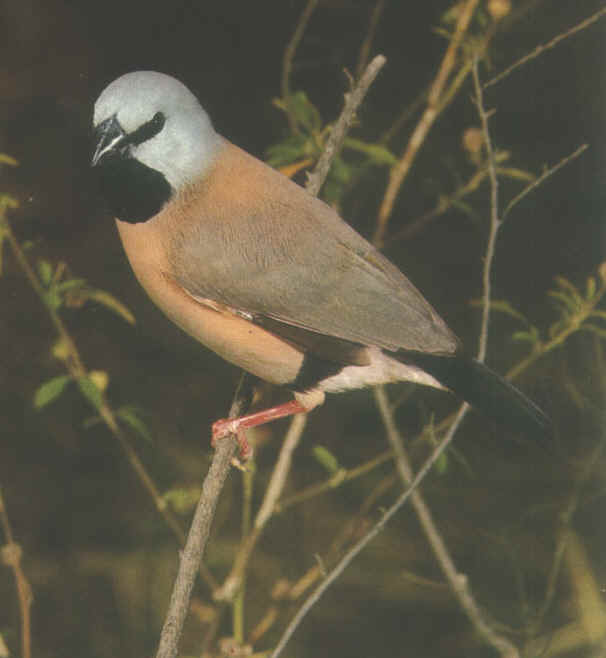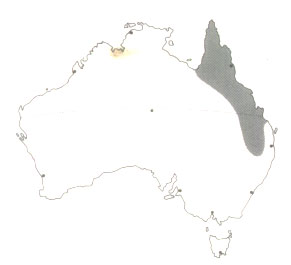![]()
 |
 |
DISTRIBUTION: Inhabits woodland savanna where water is available. Southern form uncommon over most of its range but may be common in localised areas. Northern form moderately common. |
Black-throated Finch |
Distribution Map |
|
IDENTIFICATION. LENGTH = 100 mm MALE: Head blue-grey; back fawn-brown; black bar on rump extends to lower flanks; upper tail-coverts black in northern birds, white in southern birds; tail black. Ear-patch blue-white; throat and upper breast black; lower breast, belly and flanks light brown; lower belly and undertail-coverts white. Eye dark brown; bill black; legs orange-red. FEMALE: Similar to male but slightly smaller black throat patch. IMMATURES: Similar to adults but with duller plumage.
|
NESTING. Breeds all months, but mainly autumn in north and spring in south. Nest is flask-shaped, of dead grass stems; measures 250 mm long, 140 mm high, 110 mm wide; placed in eucalypt twigs and also in hollows, termite mounds and in foundations of hawk nests. Eggs: four or five; white; 17 X 12 mm
|
|
FORMS. There are four forms. Parsons Finch, the Chocolate Parsons Finch, the Diggles Finch and the Chocolate Diggles Finch.
|
|
AVIARY BREEDING. HOUSING: These birds can be housed in their own aviary, with small parrots and or with other finches. It should be noted however that these finches are very inquisitive. NESTING TYPES: I have found that these birds will nest almost anywhere although they will usually prefer a nest box including parrot nest boxes rather than build a nest of their own. I have seen these birds build nests in tea tree branches and planted trees but very rarely. Best results have been from boxes 150 mm square X 125 mm high with a 40 mm access hole in the front and a small landing platform just below the entrance. (See the Plans page for more information) FEEDING: A general finch mix is ideal for this bird. Birds will also readily take seeding grasses and live food. However I have had seen these birds breed successfully with just a mixed seed diet. Egg and biscuit will also be taken readily. OTHER FEEDS: Cuttlebone and shell grit should be supplied at all times. SPECIAL REQUIREMENTS: There are no special requirements for this species. However care should be taken not to house this species with the Masked Finch or the Long-tailed Finch or any of the subspecies.
|
| AVIARY SPECIFICATIONS. | WIRE MESH: 1/4 x 1/4 or 6 mm x 6 mm | Also known as mouse wire |
| LENGTH: 11ft 6in or 3575 mm | WIDTH:6ft or 1800 mm | HEIGHT: 8ft or 2400 mm |
| SHED: Half the aviary should be enclosed.
These are recommendations only and individual breeders may have different dimensions and specifications.
|
FLOOR: I have found a dirt floor preferable. |
OTHER: |
|
BREEDER SUBMISSIONS. |
|
| From |
![]()
Author
P Campbell
Copyright © 2002 P. Campbell. All rights reserved.
Revised: April 20, 2002
.